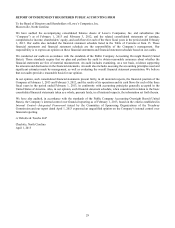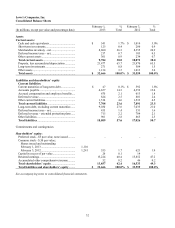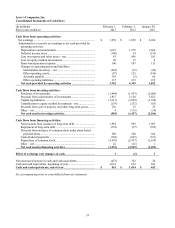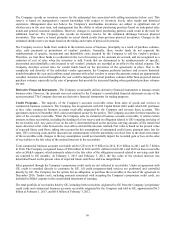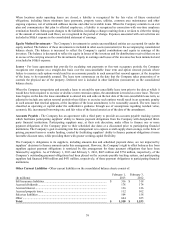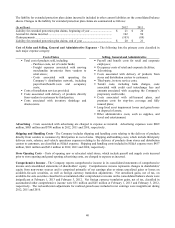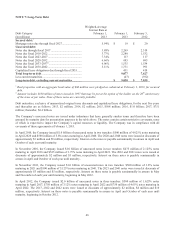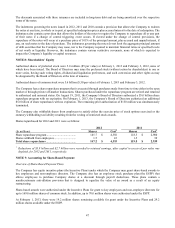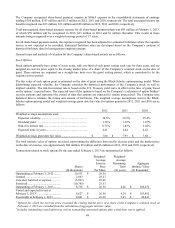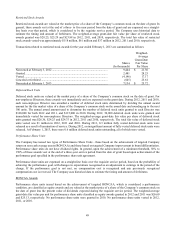Lowe's 2012 Annual Report Download - page 53
Download and view the complete annual report
Please find page 53 of the 2012 Lowe's annual report below. You can navigate through the pages in the report by either clicking on the pages listed below, or by using the keyword search tool below to find specific information within the annual report.
39
Self-Insurance - The Company is self-insured for certain losses relating to workers’ compensation, automobile, property,
and general and product liability claims. The Company has stop-loss coverage to limit the exposure arising from these
claims. The Company is also self-insured for certain losses relating to extended protection plan and medical and dental
claims. Self-insurance claims filed and claims incurred but not reported are accrued based upon management’s estimates of
the discounted ultimate cost for self-insured claims incurred using actuarial assumptions followed in the insurance industry
and historical experience. Although management believes it has the ability to reasonably estimate losses related to claims,
it is possible that actual results could differ from recorded self-insurance liabilities.
The Company provides surety bonds issued by insurance companies to secure payment of workers’ compensation liabilities
as required in certain states where the Company is self-insured. Outstanding surety bonds relating to self-insurance were
$216 million and $214 million at February 1, 2013, and February 3, 2012, respectively. The total self-insurance liability,
including the current and non-current portions, was $899 million and $864 million at February 1, 2013 and February 3,
2012, respectively.
Income Taxes - The Company establishes deferred income tax assets and liabilities for temporary differences between the
tax and financial accounting bases of assets and liabilities. The tax effects of such differences are reflected in the
consolidated balance sheets at the enacted tax rates expected to be in effect when the differences reverse. A valuation
allowance is recorded to reduce the carrying amount of deferred tax assets if it is more likely than not that all or a portion
of the asset will not be realized. The tax balances and income tax expense recognized by the Company are based on
management’s interpretation of the tax statutes of multiple jurisdictions.
The Company establishes a liability for tax positions for which there is uncertainty as to whether or not the position will be
ultimately sustained. The Company includes interest related to tax issues as part of net interest on the consolidated financial
statements. The Company records any applicable penalties related to tax issues within the income tax provision.
Revenue Recognition - The Company recognizes revenues, net of sales tax, when sales transactions occur and customers
take possession of the merchandise. A provision for anticipated merchandise returns is provided through a reduction of
sales and cost of sales in the period that the related sales are recorded. Revenues from product installation services are
recognized when the installation is completed. Deferred revenues associated with amounts received for which customers
have not yet taken possession of merchandise or for which installation has not yet been completed were $441 million and
$430 million at February 1, 2013, and February 3, 2012, respectively.
Revenues from stored-value cards, which include gift cards and returned merchandise credits, are deferred and recognized
when the cards are redeemed. The liability associated with outstanding stored-value cards was $383 million and $371
million at February 1, 2013, and February 3, 2012, respectively, and these amounts are included in deferred revenue on the
consolidated balance sheets.The Company recognizes income from unredeemed stored-value cards at the point at which
redemption becomes remote. The Company’s stored-value cards have no expiration date or dormancy fees. Therefore, to
determine when redemption is remote, the Company analyzes an aging of the unredeemed cards based on the date of last
stored-value card use.
Extended Protection Plans - The Company sells separately-priced extended protection plan contracts under a Lowe’s-
branded program for which the Company is ultimately self-insured. The Company recognizes revenue from extended
protection plan sales on a straight-line basis over the respective contract term. Extended protection plan contract terms
primarily range from one to four years from the date of purchase or the end of the manufacturer’s warranty, as applicable.
Changes in deferred revenue for extended protection plan contracts are summarized as follows:
(In millions) 2012 2011
Deferred revenue - extended protection plans, beginning of year ...................... $ 704 $ 631
Additions to deferred revenue ............................................................................. 251 264
Deferred revenue recognized .............................................................................. (240 ) (191)
Deferred revenue - extended protection plans, end of year................................. $ 715 $ 704
Incremental direct acquisition costs associated with the sale of extended protection plans are also deferred and recognized
as expense on a straight-line basis over the respective contract term. Deferred costs associated with extended protection
plan contracts were $95 million and $145 million at February 1, 2013 and February 3, 2012, respectively. The Company’s
extended protection plan deferred costs are included in other assets (noncurrent) on the consolidated balance sheets. All
other costs, such as costs of services performed under the contract, general and administrative expenses and advertising
expenses are expensed as incurred.


